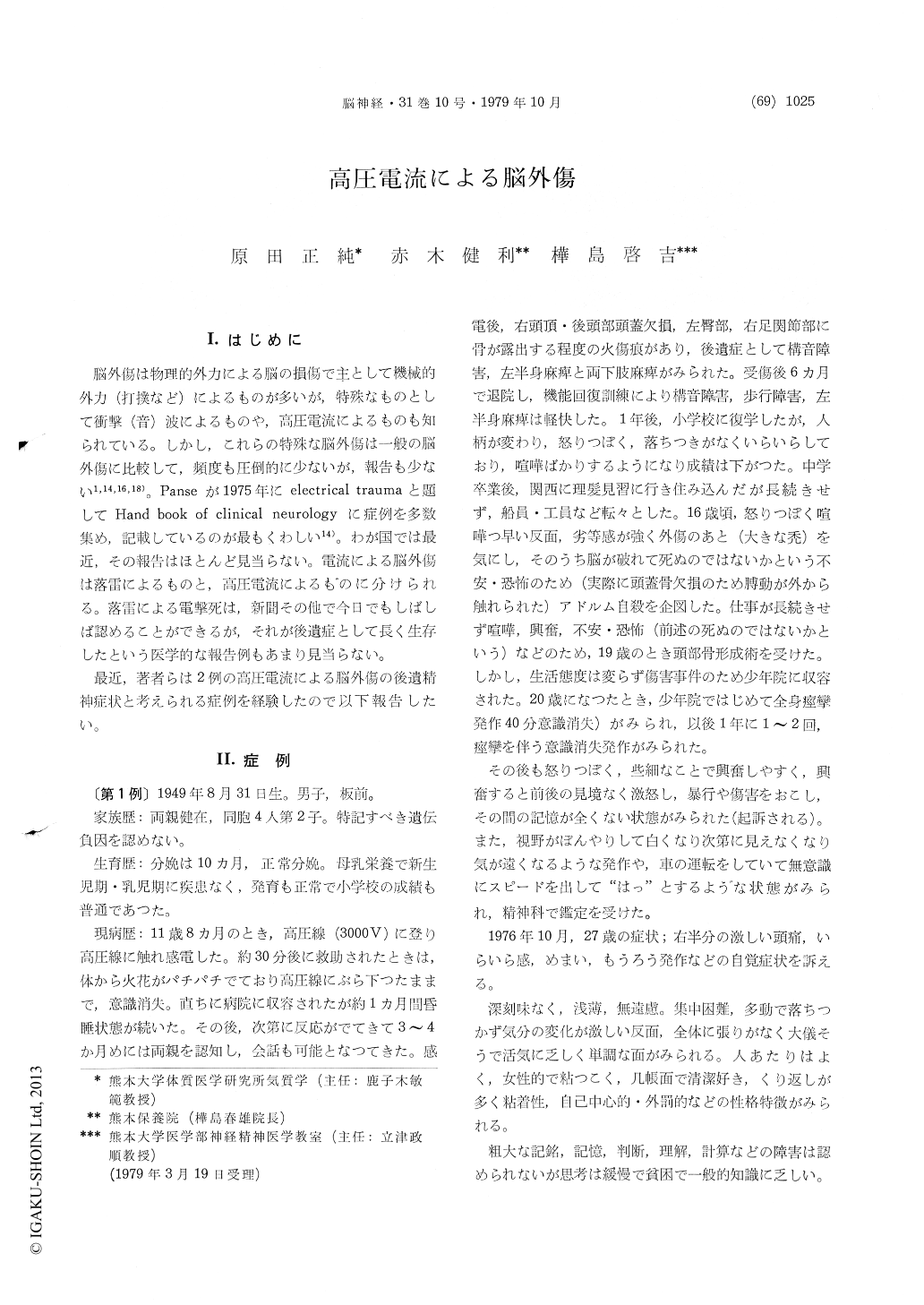Japanese
English
- 有料閲覧
- Abstract 文献概要
- 1ページ目 Look Inside
Ⅰ.はじめに
脳外傷は物理的外力による脳の損傷で主として機械的外力(打撲など)によるものが多いが,特殊なものとして衝撃(音)波によるものや,高圧電流によるものも知られている。しかし,てれらの特殊な脳外傷は一般の脳外傷に比較して,頻度も圧倒的に少点いが,報告も少ない1,14,16,18)。Panseが1975年にelectricalb traumaと題してHand book of clinical neurologyに症例を多数集め,記載しているのが最もくわしい14)。わが国では最近,その報告はほとんど見当ら点い。電流による脳外傷は落雷によるものと,高圧電流によるものに分けられる。落雷による電撃死は,新聞その他で今日でもしばしば認めることができるが,それが後遺症として長く生存したという医学的な報告例もあまり見当らない。
最近,著者らは2例の高圧電流による脳外傷の後遺精神症状と考えられる症例を経験したので以下報告したい。
Two cases of brain injury through high tension electricity were reported. The first case is a man aged 27. At age 11, the patient touched a 3,000 volt current wire and was burnt severely in the head. Deep coma continued for one month with jactitation, leaved sequestration of larg portions of right parietal bone including tabula interna, and gradual development of paper-thin membrane with scab. After the accident, spastic paralysis in both legs and left arm, dysarthria, amnestic syndrome,change of character were observed as the neuro-psychiatrical sequelae. The bone defect in the right parietal part of the skull and electric burns in the right hip and right foot suggested that current had run through the right side of the body. Until 4 years after the accident, disturbances of motor func-tion had been gradually improved. At age 20, nine years after the accident, a general convulsive and twilight seizure had occured. Up to the present, epileptic seizures have been observed with tendency to anger, irritableness, wildness, difficulty of self-control, temporary ideas of reference and persection, and suicide attempts. Therefore, the patient often changed his jobs and at last injured a person to be prosecuted.
EEG show irregular a-rhythm with suppressed a in right hemisphare and no paroxysmal dischargs.
The second case is a 57-year-old man. At age 49, he touched a 6,000 volt wire carelessly left on the road and fell in coma for two days and delirious state continued for one week. Severe burns are found also in the right side of the body including the face, forebreast, shoulder and the right upperextermity. Therefore, it was considered that the current had moved through the right side of the body. One week after the accident, amnestic syn-drome, character change, spastic tetraplegia, dys-arthria and both electric cataracts were observed. Subsequent rehabilitation of motor function for three years, however, improved the activity in his daily life to some extents, though the patient could not return to the job after all. Up to present, the patient has shown amnestic syndrome, abulia and character change such as misanthropy, tendency of isolation, difficulty of self-control, adherence.
At age 56, seven years after the accident, the patient showes slight parkinsonismus and fell in paranoid psychosis showing unmotivated laughter, monologue, hallucination and delusion. Therefore, the patient was sent to mental hospital. Computed tomography show diffuse dilatation of bilateral ventricles, third ventricle, bilateral Sylvian fissula interhemispheric fissula and cortical sulci. Irregular α rhythm with diffuse sporadic θ rhythm in EEG were seen.

Copyright © 1979, Igaku-Shoin Ltd. All rights reserved.


